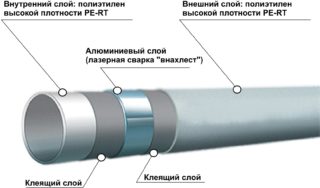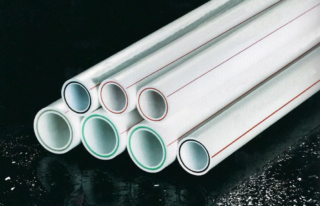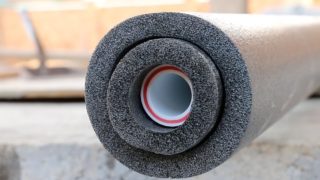The operation of an external water supply system depends not only on its installation, but also on the correct selection of pipes that can be used for drinking water in a private house underground. When choosing, they take into account what material the pipes were made from, the climatic and geological conditions of the area on which the site is located.
Types of water pipes for underground installation

Metal products are almost never used for these purposes. Steel pipelines are quite heavy, rust quickly, and are difficult to install on your own. Copper pipes are almost not afraid of rust, but at the same time their purchase and installation is irrational due to the very high cost.
Plastic pipes perfectly replace metal structures. Polymer products are better than steel ones: they are not susceptible to corrosion, and over time no fistulas or leaks appear. Plastic pipe sections are inexpensive, easy to install, and can be assembled without the use of special equipment. For water supplying polymer pipes, it is easier to find fitting elements and accessories.
For external water supply networks in a private house, options from various polymers are used:
| Material | pros | Minuses | Installation nuances |
| Low pressure polyethylene (HDPE) | Resistance to loads up to 10 atmospheres, flexibility, ease of installation. | Fear of cold weather, the need for a high-quality thermal insulation coating. | The pipe can be easily bent without much effort. To improve the quality of work, it is better to use a pipe bender. Installation is not recommended when the temperature drops below five degrees Celsius. |
| Polypropylene | Increased strength and resistance to high and low temperatures. | Lack of flexibility. | Suitable for hot water supply. Can be installed deeper than two meters. The pipeline is turned and bent by means of fittings made of a similar material. |
| Polyvinyl chloride (PVC) | Low price, light weight, easy installation. | Susceptibility to high temperatures. | They are used exclusively for cold lines. Do not lay deep - PVC is not very durable. |
Pipe sections made of metal-plastic are made of polymer, which is additionally reinforced with aluminum. Strong and durable products are not subject to thermal expansion. Such pipes are best suited for underground plumbing, but are more expensive than polymer options.
Criterias of choice

Pipe products for external water supply must comply with the following indicators:
- Quality. The pipes are manufactured in accordance with technical standards. Products should have a flat, smooth surface, without pits, creases or bulges.
- Reliability. Highways need resistance to mechanical stress, the ability to withstand high pressure.
- Environmental friendliness and safety for human health and the environment. The pipe material must not adversely affect the quality of drinking water.
- Durability. The material of the product must be resistant to wear and tear, the influence of bioprocesses - corrosion, decay, rodents and mold.
- Resistance to sudden temperature changes and immunity to soil freezing. Even a pipe with good insulation will undergo constant thermal deformation, which should not affect its performance.
All these criteria are fully met by polypropylene, metal-plastic and copper products. However, the installation of PVC and polyethylene water supply lines is also possible, taking into account the characteristics of the materials.
It is undesirable to install PVC pipelines in hard, rocky soils by trenching. They will have to be put in sleeves. With this type of soil, it is better and easier to use metal-plastic.
When buying plastic products, you need to pay attention to the marking of the pipe. For underground pipelines, the best option is PN10. PN6 models are cheaper, but do not meet the specified requirements in terms of properties.
According to state standards, products with a diameter of 32 mm and a length of 240 cm are suitable for external work. But you can buy flexible pipes of greater length, packed in coils.
When selecting water pipes, carefully inspect the surface. It should be even, free from scoring and other defects. Any scrap indicates poor quality material or the use of worn out equipment. Also, at your request, the seller must provide documents that confirm the quality of the products and their compliance with SanPin standards. It should clearly state that the pipe sections can be used for drinking systems.
Features of laying an external water supply

The supply pipeline is laid below the freezing depth of the earth. On average, this distance is equal to one and a half meters. If you lay the water supply higher, the pipes can burst from frost, or the liquid in them will rise due to ice plugs.
The freezing depth is determined depending on the climate and soil type. If you do not know the indicator in the area where the site is located, go deep 1.6 m. The heat protection of the water supply pipe will be useful. One of the best methods of insulation is considered to be laying the heating cable along the length of the pipeline.
It is cheaper to use insulation material. It must meet the following characteristics:
- low thermal conductivity;
- hygroscopicity;
- resistance to aggressive environmental influences;
- immunity to temperature extremes.
If the installation of the water supply line was carried out using metal-plastic pipes, thermal fiber can be used as a heater. The insulation has a low density, which is the main advantage. But additional insulation is needed, which increases the duration and cost of the work. Basalt wool has good quality indicators and a convenient way of laying, but at the same time it has a rather high price. For polymer pipes, polystyrene foam cases are well suited.
The laying of the water main in the ground begins with digging a ditch, which must be dug so that it does not intersect with other communication networks and does not pass under buildings. This will allow in the future not to dig up the territory at random to search for an underground pipeline. You will know exactly how the utilities are located.
The mains are laid with the creation of a slope towards the well or well to ensure the drainage of water from the water supply network in the process of performing conservation work. The length of the pipe under the foundation inside the house and to the water intake source is calculated with a half-meter margin.
It is not advisable to cover the assembled water supply system with a heat insulator and fill it up immediately after installation. It is tested throughout the day to assess the throughput and check for leaks.
Arrangement of a water supply system underground is much more economical and aesthetically pleasing than ground lines. With the correct selection of tubular products, the need to "blow up" the soil and repair the pipeline will not arise during the service life. For plastic and metal-plastic models, it is half a century.








